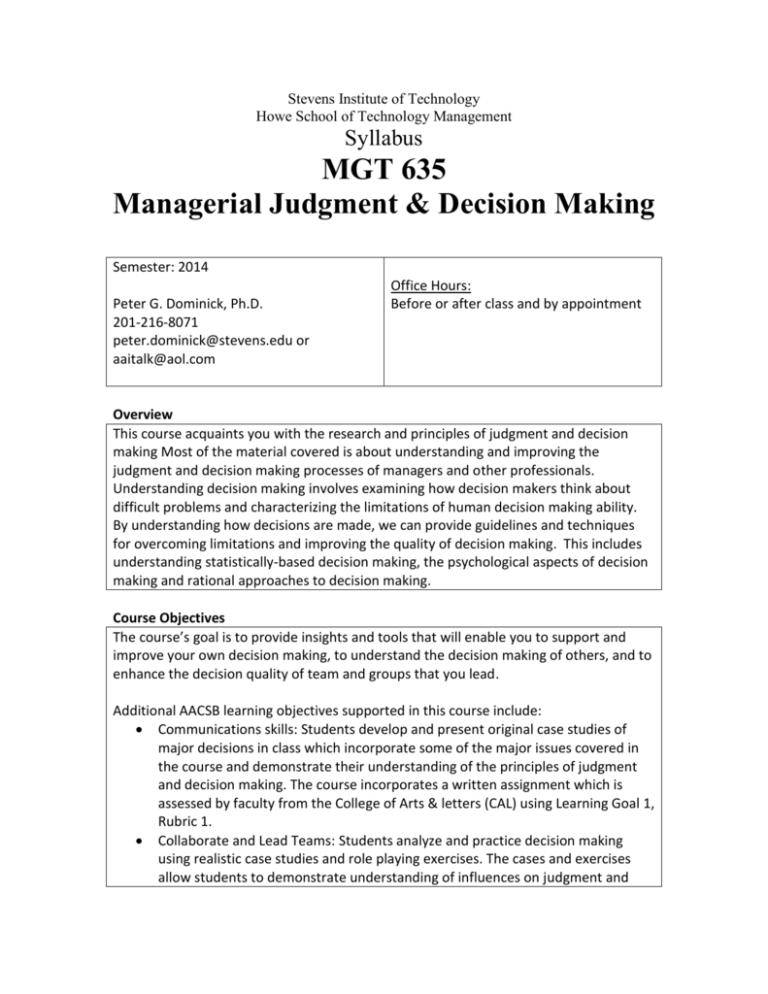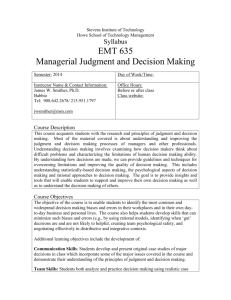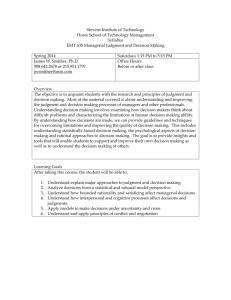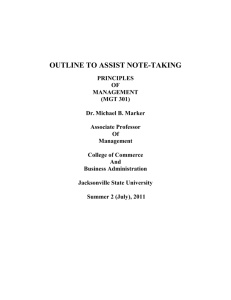Managerial Judgment & Decision Making
advertisement

Stevens Institute of Technology Howe School of Technology Management Syllabus MGT 635 Managerial Judgment & Decision Making Semester: 2014 Peter G. Dominick, Ph.D. 201-216-8071 peter.dominick@stevens.edu or aaitalk@aol.com Office Hours: Before or after class and by appointment Overview This course acquaints you with the research and principles of judgment and decision making Most of the material covered is about understanding and improving the judgment and decision making processes of managers and other professionals. Understanding decision making involves examining how decision makers think about difficult problems and characterizing the limitations of human decision making ability. By understanding how decisions are made, we can provide guidelines and techniques for overcoming limitations and improving the quality of decision making. This includes understanding statistically-based decision making, the psychological aspects of decision making and rational approaches to decision making. Course Objectives The course’s goal is to provide insights and tools that will enable you to support and improve your own decision making, to understand the decision making of others, and to enhance the decision quality of team and groups that you lead. Additional AACSB learning objectives supported in this course include: Communications skills: Students develop and present original case studies of major decisions in class which incorporate some of the major issues covered in the course and demonstrate their understanding of the principles of judgment and decision making. The course incorporates a written assignment which is assessed by faculty from the College of Arts & letters (CAL) using Learning Goal 1, Rubric 1. Collaborate and Lead Teams: Students analyze and practice decision making using realistic case studies and role playing exercises. The cases and exercises allow students to demonstrate understanding of influences on judgment and EMT 635 Managerial Judgment & Decision-Making decision-making, examine how effective decisions are made by individuals and groups and learn the role that leadership plays in helping teams make effective decisions. Ethics: The course covers fairness in decision making, drawing the distinctions among distributive, procedural, and interactional justice (using compensation decisions as an example). Second, it includes discussion on bounded ethicality, which is the idea that many unethical decisions can arise due to biases that are outside of our conscious awareness. To reinforce this concept, students complete an implicit association test, which reveals biases that are the ‘thumbprint of our culture’ despite our explicit desire to avoid such biases. ASSESSMENT: All students enrolled in MGT 635 take an ethics quiz. Learning Goals After taking this course, the you will be able to: 1. 2. 3. 4. Understand and explain major approaches to judgment and decision making Analyze decisions from a statistical and rational model perspective Understand how bounded rationality and satisficing affect managerial decisions Understand how interpersonal and cognitive processes affect decisions and judgments. 5. Apply models to make decisions under uncertainty and crisis 6. Understand and apply principles of conflict and negotiation 2 EMT 635 Managerial Judgment & Decision-Making Pedagogy The course will employ lectures, class discussions, and in-class exercises. A series of exercises are used to illustrate principles of judgment and decision making. Exercises include the taxi problem (an illustration of Bayesian reasoning), a group decision-making exercise, , a twoperson negotiation exercise, and a variety of case examples. You must complete two papers. The first requires analyzing the decision-making failures (as well as other factors) that led to the airline disaster at Tenerife, the 1996 Mt. Everest disaster and the loss of the Space Shuttle Columbia. The second requires analyzing the decision-making processes during the Cuban missile crisis. The final project requires developing an original case study of a decision, including the context, background, decision, and aftermath. You must use decision-making concepts from the course to describe and analyze the case. Each student will make a formal presentation of the case and will answer questions from the class and professor. Required Text Text: Bazerman, M.H., & Moore, D.A. (2013). Judgment in Managerial Decision Making, 8th ed., Wiley. HBs Coursepack link: https://cb.hbsp.harvard.edu/cbmp/access/23710460 Readings Week 2 1. Belkin, L. (2002). The odds of that. The New York Times Magazine, August 11. 2. Gilovich, T., Vallone, R., & Tversky, A. (1985). The hot hand in basketball: On the misperception of random sequences. Cognitive Psychology, 17, 295-314. 3. Gladwell, M. (2002). Blowing Up. The New Yorker. April 22 and 29, 162-173. 4. Reilly, R.R. (2010). Introduction to probability for decision making. Week 3 5. Galotti, K. M. (2007). Decision structuring in important real-life choices. Psychological Science, 18, 320-325. 6. Groopman, J. (2007). What’s the trouble? The New Yorker, January 29. 7. Hardman, D. & Harries, C. (2002). How rational are we? The Psychologist, 15(2), 76-79. 8. Kruger, J., Savitsky, K., & Gilovich, T. (1999). Superstition and the regression effect. Skeptical Inquirer, 23, 24-29. 9. Mishlove, J. To err is human. In ‘The Roots of Consciousness.’ http://www.williamjames.com/Science/ERR.htm. 10. Stanovich, K.E. West, R.F., Toplak, M.E. (2013). My side bias, rational thinking & intelligence. Current directions in psychological science. 22(4), 259-269. Week 4 EMT 635 Managerial Judgment & Decision-Making 11. Bohmer, R.M., Edmondson, A.C., & Roberto, M.A. (2009). Columbia’s Final Mission (Multimedia Case). HBS Publishing #305-032. 12. Gawande, A. (2007). The checklist. The New Yorker. 13. Probst, G., Raisch, S. (2005). Organizational crisis: The logic of failure. Academy of Management Executive, 19, 90-105. 14. Rosenzweig, P. (2013). What makes strategic decisions different? Harvard Business Review, November. 88-93. 15. Vaughan, D. (1997). The trickle-down effect: Policy decisions, risky work, and the Challenger tragedy. California Management Review, 39(2), 80-102. Week 5 16. Gladwell, M. (2008). The ethnic theory of plane crashes. In M. Gladwell (author), Outliers: The story of success (pp. 177-223). New York: Little, Brown, and Company 17. Milkman, K.L., Rogers, T., & Bazerman, M.H. (2008) Harnessing our inner angels and demons: What we have learned about want/should conflicts and how that knowledge can help us reduce short-sighted decision making. Perspectives on Psychological Science, 3, 324338. 18. Staw, B.M., & Hoang, H. (1995). Sunk costs in the NBA: Why draft order affects playing time and survival in professional basketball. Administrative Science Quarterly, 40, 474-494. Week 6 19. Roberto, M.A. (2002). Lessons from everest: The interaction of cognitive bias, psychological safety and system complexity. California Management Review, 45(1), 136-158, CMR245. Week 7 20. Bruck, C. (2009). Angelo’s ashes. The New Yorker, June 29. 21. Eden, D., & Shani, A. B. (1982). Pygmalion goes to boot camp: Expectancy, leadership, and trainee performance. Journal of Applied Psychology, 67(2), 194-199. 22. Gladwell, M. (2004). Personality plus. The New Yorker, September 20. 23. Shih, M., Pittinsky, T. L., & Ambady, N. (1999). Stereotype susceptibility: Identity salience and shifts in quantitative performance. Psychological Science, 10, 80-83. Week 8 24. Folger, R., & Konovsky, M.A. (1989). Effects of procedural and distributive justice on reactions to pay raise decisions. Academy of Management Journal, 32, 115-130. 25. Zhang, S., Cornwell, J.F., & Higgins, E.T. (2013). Repeating the past: Prevention focus motivates repetition, even for unethical decisions. Psychological Science, November. Week 10 26. Hyashi, A.M, (2001, February). When to trust your gut. Harvard Business Review, 59-65. 27. Lehrer, J. (2008, July 28). The eureka hunt. The New Yorker, 40-45. 28. Myers, D.G. (2002, November/December). The powers and perils of intuition. Psychology Today, 42-52. 29. Willis, J., & Todorov, A. (2006). First impressions: Making up your mind after a 100-ms exposure to a face. Psychological Science, 17, 592-598. Week 12 30. Begley, S. (2010, August 5). The limits of reason: Why evolution may favor irrationality. Newsweek, http://www.newsweek.com/search.html?q=The+limits+of+reason 31. Bhide, A. (2010). The Judgment deficit. Harvard Business Review. Sept. 44-53. 4 EMT 635 Managerial Judgment & Decision-Making 32. Milkman, K.L., Chugh, D., & Bazerman, M.H. (2009). How can decision making be improved? Perspectives on Psychological Science, 4, 379-383. 5 EMT 635 Managerial Judgment & Decision-Making Assignments The course will emphasize class discussion focused around the exercises and the analysis of the text and other assigned readings. You are expected to be prepared to discuss the assigned readings as well as concepts and examples in the text. Two papers (each analyzing decision making cases) are assigned plus an original final case study. Class Participation To enhance the learning experience for everyone, you are expected to participate in class discussions and team exercises. Attendance is an important component of this grade. In addition, each student will prepare and deliver a brief presentation on one of the assigned readings. The assignments and their weights are as shown below: Assignment Case Study I (see page 6) Case Study II (see page 6) Final Presentation (see page 6) Article Presentation and Class Participation (see page 6) Total Grade Grade Percent 25% 25% 35% 15% 100% 6 EMT 635 Managerial Judgment & Decision-Making Course Schedule Topic Readings and other activities Session Course overview Session 1 1/15 Randomness and statistical models Everyone read: 4 –Reilly, Introduction to Probability for Decision-making Short Presentation Readings Choices: 1-3 Common Biases & Framing Everyone Read: Bazerman & Moore Chapters 1,2,4 Effects Short Presentation Readings Choices: 5-10 System Complexity & Everyone Read: 10 – Bohmer, et. al. Columbia’s Decision Failures Final Mission (DVD) ; 16-Vaughn, The Trickle Down effect Short Presentation Readings Choices: 11-14 Non-rational escalation of Everyone Read: Bazerman & Moore Chapter 7 commitment Short Presentation Readings Choices: 16-18 Tenerife: The Deadliest Plane Crash - NOVA Group decision making Everyone Read: 20. Roberto, M.A. (2002). Lessons from everest. Everest Simulation in class Motivational and emotional Everyone Read: Bazerman & Moore Chapter 6 influences on decision making Short Presentation Readings Choices: 20-23 Session 2 1/22 Fairness and ethics in decision making Everyone Read: Bazerman & Moore Chapter 8 Short Presentation Readings Choices: 24-25 Session 8 3/26 Decision Dynamics Tenerife, Columbia and Mt. Everest paper due Session 9 4/2 Session 3 2/12 Session 4 2/19 Session 5 2/26 Session 6 3/5 Session 7 3/19 Cuban Missile Crisis video Short Presentation Readings Choices: 26-29 Implicit association test (IAT) https://implicit.harvard.edu/implicit/ Everyone Read: Bazerman & Moore Chapters 10 and 11 ARAK simulation Session 10 4/9 Session 11 4/16 Improving decision making Wrap-up and Catch up discussions if needed Everyone Read: Bazerman & Moore Chapter 12 Short Presentation Readings Choices: 30-32 Student Case Presentations Session 12 4/23 Wrap-up Student Case presentations (Continued) Paper on Cuban missile crisis due Session 13 4/30 Intuitive judgment & improvisational thinking Decision making in negotiations 7 EMT 635 Managerial Judgment & Decision-Making Presentations on Assigned Readings Each week one or more readings will be assigned to one or two students. Prepare a 10to 15-minute presentation on each reading. Do not try to present all the details about the article; only present sufficient information so that we will all understand the key findings/points. Summarize the article What are the essential points made by the author? Discuss the implications of the article for decision making Case Study 1: Columbia, Tenerife and Mt. Everest After learning about the Columbia’s final mission, the air disaster at Tenerife , and the events on Mt. Everest in 1996, prepare a report that compares and contrasts two of these events. The individual-level decision making biases that contributed to the disasters The team-level factors (or processes) that contributed to the disasters The systems-level factors that contributed to the disasters Be sure to emphasize the similarities in individual-level, team-level, and systems-level factors that contributed to both disasters. The report should be no longer than 5 doublespaced pages. Case Study 2: Cuban Missile Crisis Write a report analyzing the decisions made in the Cuban Missile crisis. Your report should utilize the concepts covered by Bazerman and the assigned readings to answer 35 of the following questions. The report should be no longer than 5 double-spaced pages. 1. What were the major issues to be decided? 2. What were the major sources of uncertainty? 3. What were the key decisions made during the crisis? 4. How did framing affect the decision makers and the decision process? 5. To what extent did the decision makers generate alternatives? 6. Describe the decision-making process used by President Kennedy? 7. What were the key sources of influence on the ultimate decision? 8. In retrospect, could a better set of decisions have been made from the U.S. perspective? Final Presentation The final project requires developing an original case study of a decision, including the context, background, decision, and aftermath. You must use decision-making concepts from the course to describe and analyze the case (15-20 minutes). Each student will make a formal presentation of the case and will answer questions from the class and professor. This can be a team presentation. 8 EMT 635 Managerial Judgment & Decision-Making Ethical Conduct The following statement applies to all students taking Stevens courses, on and off campus. “Cheating during in-class tests or take-home examinations or homework is, of course, illegal and immoral. A Graduate Academic Evaluation Board exists to investigate academic improprieties, conduct hearings, and determine any necessary actions. The term ‘academic impropriety’ is meant to include, but is not limited to, cheating on homework, during in-class or take home examinations and plagiarism.” Consequences of academic impropriety are severe, ranging from receiving an ‘F’ in a course, to a warning from the Dean of the Graduate School, which becomes a part of the permanent student record, to expulsion. Reference: The Graduate Student Handbook, Academic Year 2003-2004 Stevens Institute of Technology, page 10. Consistent with the above statements, all homework exercises, tests and exams that are designated as individual assignments MUST contain the following signed statement before they can be accepted for grading. _______________________________________________________________________ I pledge on my honor that I have not given or received any unauthorized assistance on this assignment/examination. I further pledge that I have not copied any material from a book, article, the Internet or any other source except where I have expressly cited the source. Signature _______________________________________ Date: _____________ Please note that assignments in this class may be submitted to www.turnitin.com, a web-based anti-plagiarism system, for an evaluation of their originality. 9








